Southeast Missouri State University
River Campus Mural
March 1 2007 - September 1, 2007
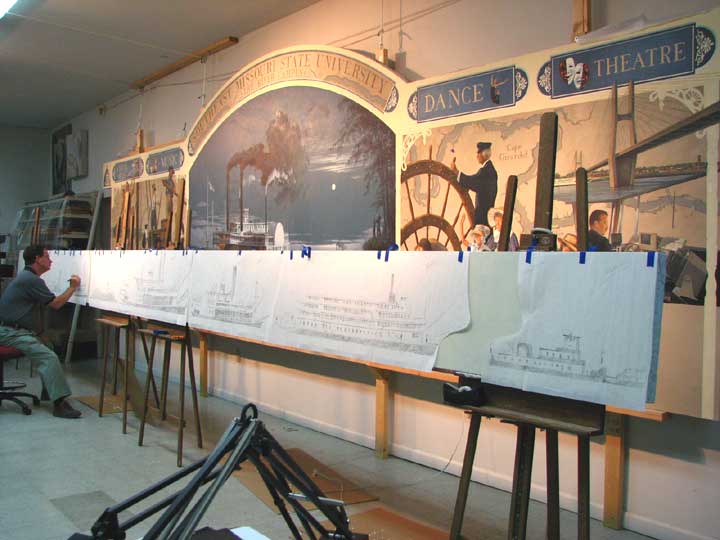 With the upper section of the mural
95% complete, I am ready to begin the drawing for the Mississippi
River Maritime
time line that will run across the
bottom of the mural. I have been working on the drawing for two
weeks. The vessels are drawn
to scale to compare the size progression
over the centuries. Thus, a one inch tall person placed on the
keelboat will feel
at home and in scale riding aboard
the Delta Queen.
With the upper section of the mural
95% complete, I am ready to begin the drawing for the Mississippi
River Maritime
time line that will run across the
bottom of the mural. I have been working on the drawing for two
weeks. The vessels are drawn
to scale to compare the size progression
over the centuries. Thus, a one inch tall person placed on the
keelboat will feel
at home and in scale riding aboard
the Delta Queen.
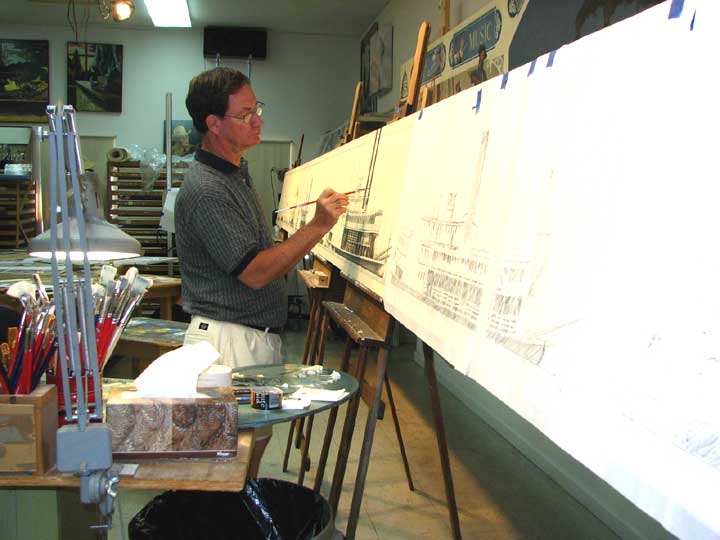 With the drawings complete and the
images transferred to the canvas, I begin the process
of painting each vessel.
With the drawings complete and the
images transferred to the canvas, I begin the process
of painting each vessel.
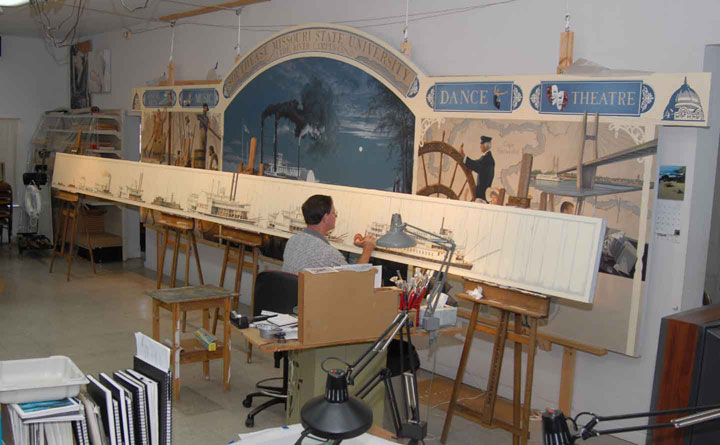
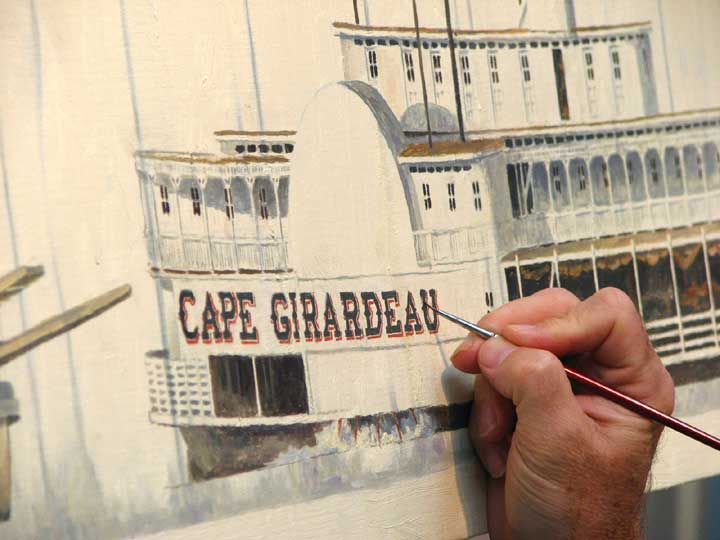
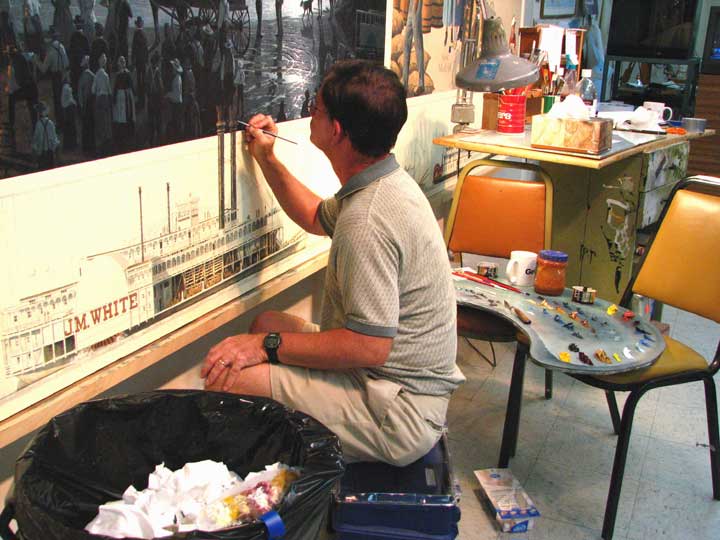 After all the painting is completed
using the free standing easels,
the lower panel is attached to the
main body of the mural. After joining the
two sections some images are extended
onto the surface of the adjoining panel. The chimneys of
the J. M. White were too high to be
depicted on the lower panel alone.
After all the painting is completed
using the free standing easels,
the lower panel is attached to the
main body of the mural. After joining the
two sections some images are extended
onto the surface of the adjoining panel. The chimneys of
the J. M. White were too high to be
depicted on the lower panel alone.
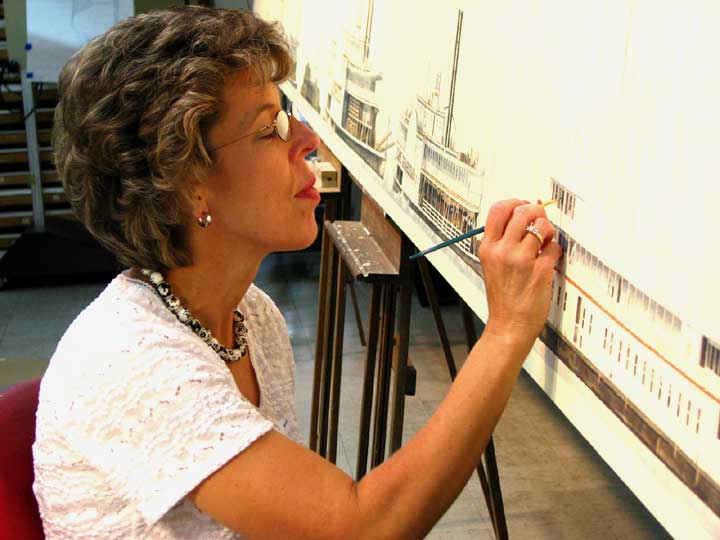 Moving on to painting the Delta Queen,
Sandy added her expertise to the mural. A few years ago Sandy
and I were invited to travel aboard
the Delta Queen from Red Wing, Minnesota to St. Louis.
I gave several lectures on river history
and a couple of painting demonstrations. Our cabin was on the
third deck,
next to the last cabin from the stern.
After mixing the proper color for the window, I asked her if she
would like
to paint the window of our cabin on
the Delta Queen.
After 2008, the Delta Queen will no
longer travel the Inland Waterways. She is being
decommissioned. This is, in my opinion,
the end of the true steamboat era. She was the
last true steam-powered, paddle-wheeled
vessel with overnight accommodations on the river today.
Moving on to painting the Delta Queen,
Sandy added her expertise to the mural. A few years ago Sandy
and I were invited to travel aboard
the Delta Queen from Red Wing, Minnesota to St. Louis.
I gave several lectures on river history
and a couple of painting demonstrations. Our cabin was on the
third deck,
next to the last cabin from the stern.
After mixing the proper color for the window, I asked her if she
would like
to paint the window of our cabin on
the Delta Queen.
After 2008, the Delta Queen will no
longer travel the Inland Waterways. She is being
decommissioned. This is, in my opinion,
the end of the true steamboat era. She was the
last true steam-powered, paddle-wheeled
vessel with overnight accommodations on the river today.
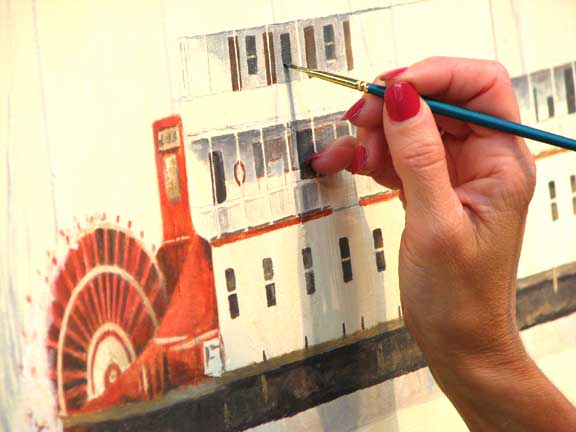 Nice touch!!!
Nice touch!!!
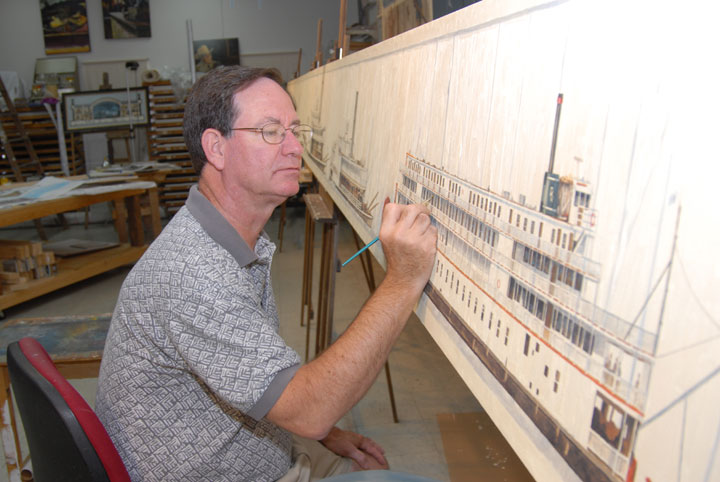
 The time line as it appears on the
mural. Yes, there were many vessels other than these that
traveled on the Mississippi River.
I chose these vessels as a representation of the evolvement of
technology in river travel for thousands
of years. All the vessels are depicted in scale to one another
to accent the ever expanding dimensions
of boats on the river.
The time line as it appears on the
mural. Yes, there were many vessels other than these that
traveled on the Mississippi River.
I chose these vessels as a representation of the evolvement of
technology in river travel for thousands
of years. All the vessels are depicted in scale to one another
to accent the ever expanding dimensions
of boats on the river.
 From left to right, please follow my
vessels of the river time line.
1. Dug
out canoe. The dug out canoe was the mainstay
for thousands of years. Simple to build...easy to maintain.
2. Flatboat. After the Europeans came to America, their vessels
began to dominate the river highways. The flatboat was a
downstream form of transportation only.
When the boats reached their destination, in most cases New Orleans,
they were torn apart and sold as lumber.
3.
Keelboat. The keelboat
could travel not only downstream but upstream as well by use of
cordelling - pulling the boat from land with a long
towline,
poling, rowing, and sailing. Prior to the steamboat, this was
the only way to carry large quantities of cargo upstream.
4.
Steamboat, New Orleans. In 1811, the western rivers moved toward the use of
steam technology. The New Orleans was the first
steamboat
on the western rivers. Note the use of sails. Although they were
never or very seldon used, they felt that steam power
could use a little backup.
5.
The Yellowstone. By
the 1830's, steamboats were beginning to resemble the image we
equate with a steamboat. Although
still underpowered, the vessels of
the 1830's were making the river highways their home. The Yellowstone
was the
first steamboat to travel up the treacherous
Missouri River to Ft. Union at present day Williston, ND.
6. The Arabia.
This steamboat is a representation
of the size and stature of the 1850's vessel. The 1850's were
the real heyday of
the steamboat era. It wasn't until
after the Civil War that the grand boats we identify as steamboats
were built.
From left to right, please follow my
vessels of the river time line.
1. Dug
out canoe. The dug out canoe was the mainstay
for thousands of years. Simple to build...easy to maintain.
2. Flatboat. After the Europeans came to America, their vessels
began to dominate the river highways. The flatboat was a
downstream form of transportation only.
When the boats reached their destination, in most cases New Orleans,
they were torn apart and sold as lumber.
3.
Keelboat. The keelboat
could travel not only downstream but upstream as well by use of
cordelling - pulling the boat from land with a long
towline,
poling, rowing, and sailing. Prior to the steamboat, this was
the only way to carry large quantities of cargo upstream.
4.
Steamboat, New Orleans. In 1811, the western rivers moved toward the use of
steam technology. The New Orleans was the first
steamboat
on the western rivers. Note the use of sails. Although they were
never or very seldon used, they felt that steam power
could use a little backup.
5.
The Yellowstone. By
the 1830's, steamboats were beginning to resemble the image we
equate with a steamboat. Although
still underpowered, the vessels of
the 1830's were making the river highways their home. The Yellowstone
was the
first steamboat to travel up the treacherous
Missouri River to Ft. Union at present day Williston, ND.
6. The Arabia.
This steamboat is a representation
of the size and stature of the 1850's vessel. The 1850's were
the real heyday of
the steamboat era. It wasn't until
after the Civil War that the grand boats we identify as steamboats
were built.
 7. The "Iron Clad" Carondolet.
The Carondolet was one of seven
city class iron clads designed and built by James Eads
for the Union army. The Civil War was
a great turning point for the rivers. Afterwards, the railroads
began
their steady domination of the rivers.
8. The J. M. White, 1878.
To compete with the
railroads, the river interests decided to build some of the grandest
vessels ever conceived.
The railroad may be faster, but river
travel was more comfortable, as in the case of the
J.M. White, the most luxurious steamboat
ever built. Unfortunately, the public opted for speed not luxury.
The J.M. White
never turned a profit and burned in
1886.
9. The Cape Girardeau. The Cape Girardeau embodies the evolvement of the steamboat
into the last part of the 19th century, fast and
efficient. However, these vessels proved
to be no competion for the railroad industry.
7. The "Iron Clad" Carondolet.
The Carondolet was one of seven
city class iron clads designed and built by James Eads
for the Union army. The Civil War was
a great turning point for the rivers. Afterwards, the railroads
began
their steady domination of the rivers.
8. The J. M. White, 1878.
To compete with the
railroads, the river interests decided to build some of the grandest
vessels ever conceived.
The railroad may be faster, but river
travel was more comfortable, as in the case of the
J.M. White, the most luxurious steamboat
ever built. Unfortunately, the public opted for speed not luxury.
The J.M. White
never turned a profit and burned in
1886.
9. The Cape Girardeau. The Cape Girardeau embodies the evolvement of the steamboat
into the last part of the 19th century, fast and
efficient. However, these vessels proved
to be no competion for the railroad industry.
 10. The Delta Queen. Built in 1926 and decomissioned in 2008, she was
the
last true steam-powered, paddle-wheeled
vessel with over night accommodations on the river today.
Thus, in my opinion, the end of the
true steamboat era.
11. The Peter Fanchi. Built in 1977, she is not the true giant of today's
tow boats, however,
she embodies the new generation of
vessels that are the mainstay of the river today. Peter Fanchi
Sr. is also a friend of mine.
10. The Delta Queen. Built in 1926 and decomissioned in 2008, she was
the
last true steam-powered, paddle-wheeled
vessel with over night accommodations on the river today.
Thus, in my opinion, the end of the
true steamboat era.
11. The Peter Fanchi. Built in 1977, she is not the true giant of today's
tow boats, however,
she embodies the new generation of
vessels that are the mainstay of the river today. Peter Fanchi
Sr. is also a friend of mine.
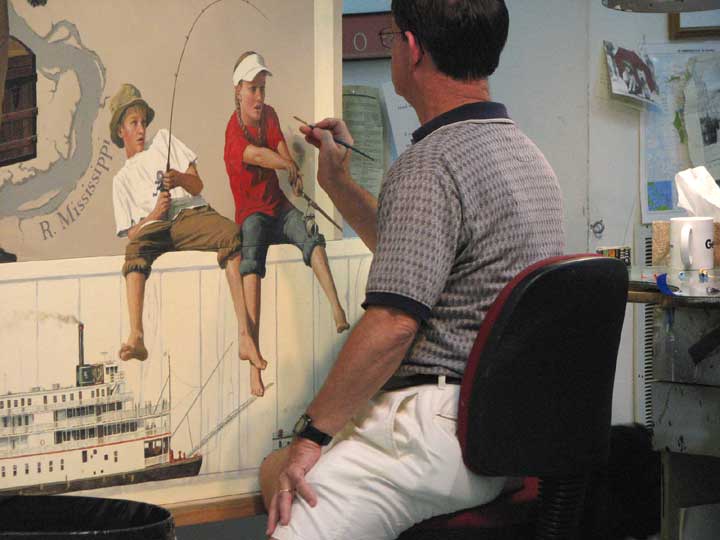 My last job is painting the kids fishing....the
fun part of the river. Thanks to Anna and Andrew Fischer for their
modeling talents.
My last job is painting the kids fishing....the
fun part of the river. Thanks to Anna and Andrew Fischer for their
modeling talents.
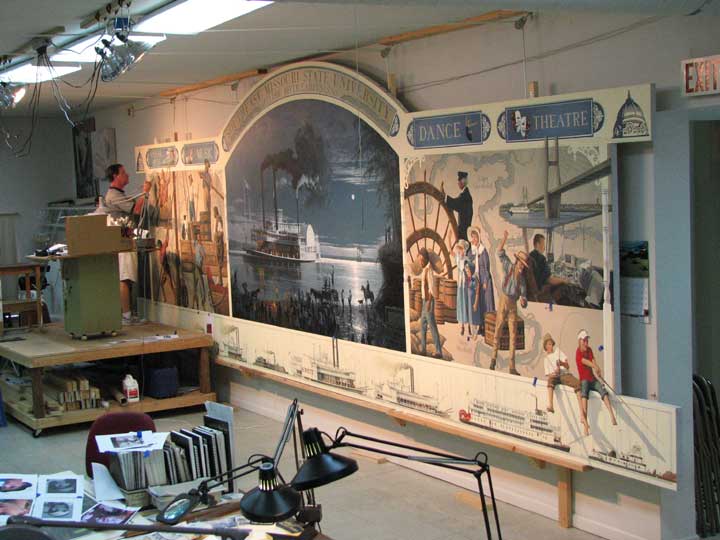 A few last minute touches and the mural
will be ready to ship. I have a quote on my wall in the studio,
"An artist never really finishes
his work, he simply abandons it"
Very true.
All the best to you,
A few last minute touches and the mural
will be ready to ship. I have a quote on my wall in the studio,
"An artist never really finishes
his work, he simply abandons it"
Very true.
All the best to you,
 Next
Page
Back
to Previous Page
Return
to Gary R. Lucy Gallery Home page
Return
to Mural Journal Home page
Next
Page
Back
to Previous Page
Return
to Gary R. Lucy Gallery Home page
Return
to Mural Journal Home page















